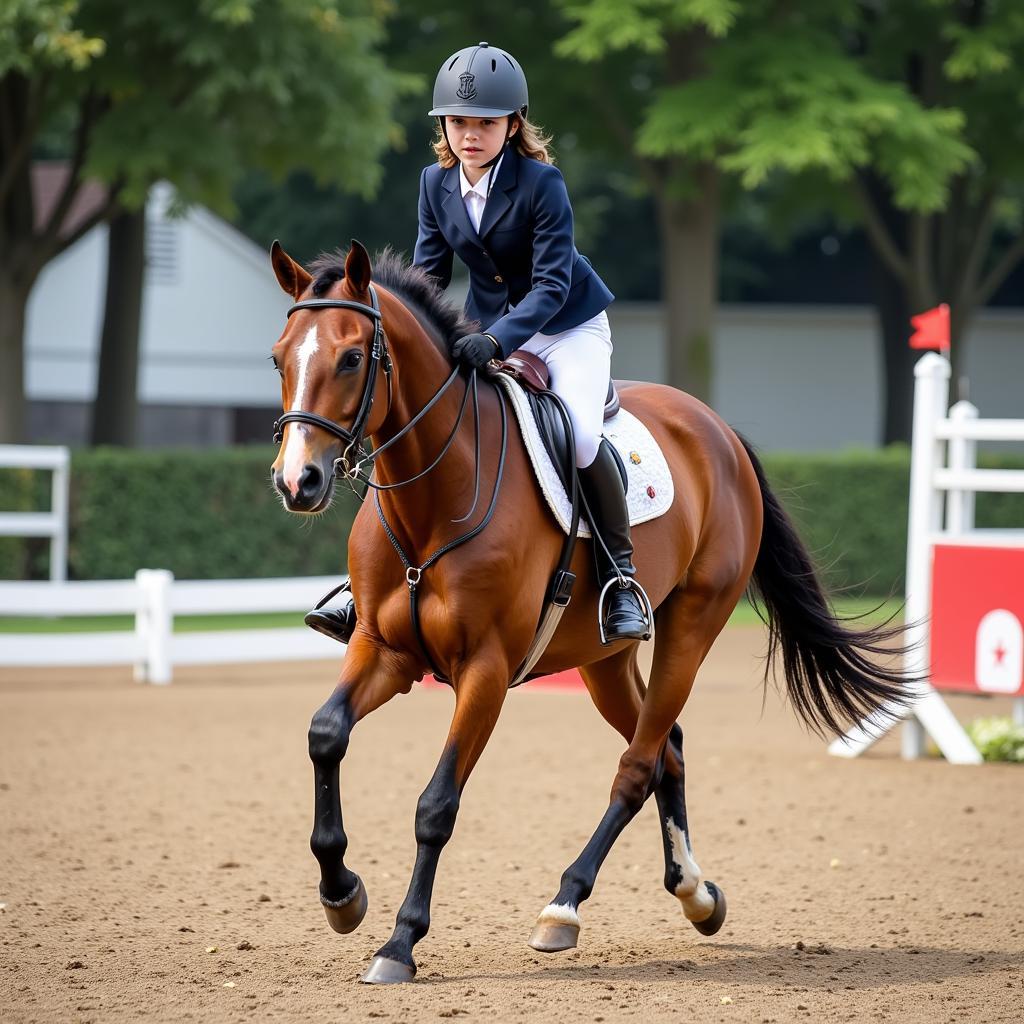Maryland Horse And Pony Shows offer a vibrant and competitive scene for equestrians of all ages and skill levels. Whether you’re a seasoned competitor or a curious spectator, understanding the nuances of these events can greatly enhance your experience. From choosing the right class to preparing your horse, this guide will equip you with the knowledge you need to navigate the Maryland horse and pony show circuit.
What to Expect at a Maryland Horse and Pony Show
Maryland boasts a rich equestrian tradition, and its horse and pony shows are a testament to this heritage. These events showcase a wide variety of disciplines, including hunter, jumper, dressage, and equitation. They range from local, low-key schooling shows to prestigious, nationally recognized competitions. This diversity allows riders to find the perfect fit for their goals and experience levels. Attending a Maryland horse and pony show is a great way to immerse yourself in the equestrian community, learn from experienced riders, and witness impressive displays of horsemanship. Before heading to your first show, it’s beneficial to familiarize yourself with the common formats and procedures.
Many shows offer classes specifically designed for young riders and ponies, fostering a supportive environment for learning and growth. These classes often have adjusted rules and expectations to accommodate the younger participants. Experienced riders can also find ample opportunities to challenge themselves in the higher-level divisions, showcasing their advanced skills and finely tuned partnerships with their horses. Regardless of your experience level, Maryland horse and pony shows offer something for everyone.
Choosing the Right Class for Your Horse and Pony
Selecting the appropriate class is crucial for both your and your horse or pony’s success. Consider your current skill level, your horse’s strengths and weaknesses, and your long-term goals. Are you focusing on hunter, jumper, or dressage? Within each discipline, classes are further categorized by age, experience, and height of the horse or pony. Don’t be afraid to ask experienced trainers or show organizers for guidance. They can offer valuable insights and help you choose the classes that best suit your needs.
 Rider and Pony in Show Ring: A young rider on a pony navigating a course of jumps during a competition.
Rider and Pony in Show Ring: A young rider on a pony navigating a course of jumps during a competition.
For beginners, starting with introductory classes like walk-trot or leadline is recommended. These classes provide a foundation in basic riding skills and showmanship. As you progress, you can gradually move up to more challenging classes involving canter, jumps, or more complex dressage movements. Choosing the right class ensures a positive and rewarding experience for both horse and rider.
Preparing Your Horse for a Maryland Horse and Pony Show
Preparing for a horse and pony show involves more than just practicing your riding skills. It also requires meticulous attention to your horse’s physical and mental well-being. Ensure your horse is in peak condition through regular exercise, a balanced diet, and routine veterinary checkups. Grooming is also essential, not just for aesthetics but also for the horse’s comfort and health. A clean and well-groomed horse reflects the rider’s dedication and professionalism.
Packing the right equipment is crucial. This includes all necessary tack, grooming supplies, first-aid kit, and any specific attire required for your chosen discipline. Creating a checklist can help ensure you don’t forget anything essential on show day. Remember to arrive early to allow ample time for warm-up, tacking up, and familiarizing your horse with the showgrounds environment. Adequate preparation contributes significantly to a smooth and successful show experience.
Conclusion
Maryland horse and pony shows provide a wonderful opportunity to celebrate the equestrian lifestyle, test your skills, and connect with fellow horse enthusiasts. From the thrill of competition to the camaraderie of the community, these events offer a unique and rewarding experience. By following the tips outlined in this guide, you can confidently navigate the Maryland horse and pony show circuit and make the most of your time in the ring. Remember, choosing the right class, preparing your horse thoroughly, and understanding the show procedures are key to a successful and enjoyable experience.
FAQ
-
What age do children typically start showing ponies? Children can start participating in leadline classes as young as three or four years old.
-
Do I need my own horse to participate in a show? Not necessarily. Many riding stables offer lesson horses that can be used for shows.
-
What type of attire is required for different disciplines? Attire varies depending on the discipline. Hunter riders typically wear traditional hunt coats, while dressage riders wear formal attire.
-
How can I find a reputable trainer in Maryland? Local equestrian organizations and online directories can help you connect with qualified trainers in your area.
-
What are the costs associated with showing horses and ponies? Costs vary depending on the show, the discipline, and the level of competition.
-
Are there any specific rules for ponies in Maryland shows? Yes, pony classes often have specific height restrictions and equipment regulations.
-
Where can I find a schedule of upcoming Maryland horse and pony shows? Several websites and equestrian publications list upcoming shows in Maryland.
For more information and assistance, contact us at Phone: 0772127271, Email: [email protected] or visit us at QGM2+WX2, Vị Trung, Vị Thuỷ, Hậu Giang, Việt Nam. We have a 24/7 customer service team. You can also explore more articles and resources on our website, Justus Horses USA, to deepen your knowledge about horse care and equestrian events. We encourage you to check out our articles on “Choosing the Right Saddle” and “Understanding Horse Nutrition.” We are dedicated to providing valuable information and support to the equestrian community.